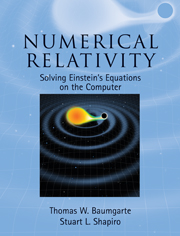Book contents
- Frontmatter
- Contents
- Preface
- Suggestions for using this book
- 1 General relativity preliminaries
- 2 The 3 + 1 decompostion of Einstein's equations
- 3 Constructing initial data
- 4 Choosing coordinates: the lapse and shift
- 5 Matter sources
- 6 Numerical methods
- 7 Locating black hole horizons
- 8 Spherically symmetric spacetimes
- 9 Gravitational waves
- 10 Collapse of collisionless clusters in axisymmetry
- 11 Recasting the evolution equations
- 12 Binary black hole initial data
- 13 Binary black hole evolution
- 14 Rotating stars
- 15 Binary neutron star initial data
- 16 Binary neutron star evolution
- 17 Binary black hole–neutron stars: initial data and evolution
- 18 Epilogue
- A Lie derivatives, Killing vectors, and tensor densities
- B Solving the vector Laplacian
- C The surface element on the apparent horizon
- D Scalar, vector and tensor spherical harmonics
- E Post-Newtonian results
- F Collisionless matter evolution in axisymmetry: basic equations
- G Rotating equilibria: gravitational field equations
- H Moving puncture representions of Schwarzschild: analytical results
- I Binary black hole puncture simulations as test problems
- References
- Index
11 - Recasting the evolution equations
Published online by Cambridge University Press: 05 March 2013
- Frontmatter
- Contents
- Preface
- Suggestions for using this book
- 1 General relativity preliminaries
- 2 The 3 + 1 decompostion of Einstein's equations
- 3 Constructing initial data
- 4 Choosing coordinates: the lapse and shift
- 5 Matter sources
- 6 Numerical methods
- 7 Locating black hole horizons
- 8 Spherically symmetric spacetimes
- 9 Gravitational waves
- 10 Collapse of collisionless clusters in axisymmetry
- 11 Recasting the evolution equations
- 12 Binary black hole initial data
- 13 Binary black hole evolution
- 14 Rotating stars
- 15 Binary neutron star initial data
- 16 Binary neutron star evolution
- 17 Binary black hole–neutron stars: initial data and evolution
- 18 Epilogue
- A Lie derivatives, Killing vectors, and tensor densities
- B Solving the vector Laplacian
- C The surface element on the apparent horizon
- D Scalar, vector and tensor spherical harmonics
- E Post-Newtonian results
- F Collisionless matter evolution in axisymmetry: basic equations
- G Rotating equilibria: gravitational field equations
- H Moving puncture representions of Schwarzschild: analytical results
- I Binary black hole puncture simulations as test problems
- References
- Index
Summary
At this point we might suspect that we are all set to carry out dynamical simulations involving relativistic gravitational fields in three spatial dimensions, i.e., dynamical simulations in full 3 + 1 dimensional spacetimes. After all, we have derived the 3 + 1 evolution equations for the gravitational fields in Chapter 2, developed techniques for the construction of initial field data in Chapter 3, and discussed strategies for imposing suitable coordinate conditions in Chapter 4. Should the spacetime in which we are interested contain the most common matter sources, we can consult Chapter 5 for the matter source terms and the matter equations of motion. Beyond assembling all of the relevant equations, we have also sketched algorithms for solving them numerically in Chapter 6. If black holes are present, we have derived methods to locate and measure their horizons in Chapter 7; if gravitational waves are generated we have discussed how to extract radiation wave forms numerically in Chapter 9. Finally, we have evolved relativistic systems in spherical symmetry (1 + 1 dimensions) in Chapter 8 and in axisymmetry (2 + 1 dimensions) in Chapter 10. What else is left to do before going on to perform simulations in full 3 + 1 dimensions?
Suppose then we were to plunge ahead with the tools currently at our disposal to build a dynamical spacetime in 3 + 1 dimensions. We could gain some confidence and computational experience by choosing to explore as our first case a simple dynamical system with a known analytic solution.
- Type
- Chapter
- Information
- Numerical RelativitySolving Einstein's Equations on the Computer, pp. 375 - 393Publisher: Cambridge University PressPrint publication year: 2010



